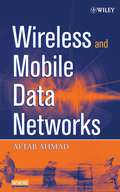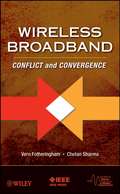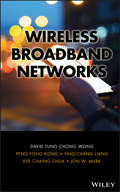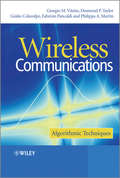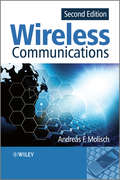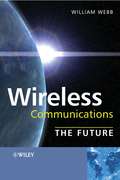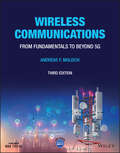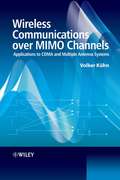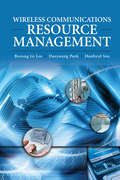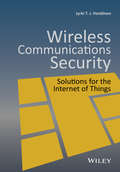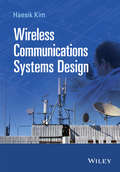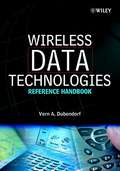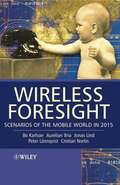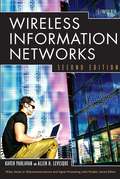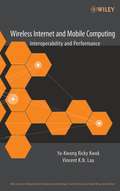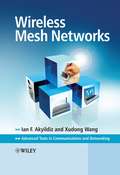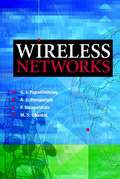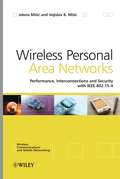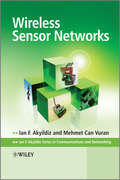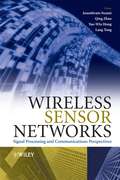- Table View
- List View
Wireless and Mobile Data Networks
by Aftab AhmadWireless and Mobile Data Networks provides a single point of knowledge about wireless data technologies, including: * Comprehensive easy-to understand resource on wireless data technologies * Includes wireless media, data transmission via cellular networks, and network security * Provides a single point of knowledge about wireless data * Focuses on wireless data networks, wireless channels, wireless local networks, wide area cellular networks and wireless network security An Instructor Support FTP site is available from the Wiley editorial department.
Wireless Broadband: Conflict and Convergence (IEEE Series on Digital & Mobile Communication #19)
by Vern Fotheringham Chetan SharmaWireless Broadband utilizes a reader-friendly approach to clearly explain the business, regulatory, and technology issues of the future market for wireless services. It covers broadband and the information society; drivers of broadband consumption; global wireless market analysis; broadband IP core networks; convergence; and contention and conflict. Complemented with more than eighty illustrations, this book provides unparalleled insight into the emerging technologies, service delivery options, applications, and digital content that will influence and shape the next phase of the wireless revolution.
Wireless Broadband Networks
by David T. Wong Peng-Yong Kong Ying-Chang Liang Kee C. ChuaAn introduction to theories and applications in wireless broadband networks As wireless broadband networks evolve into future generation wireless networks, it's important for students, researchers, and professionals to have a solid understanding of their underlying theories and practical applications. Divided into two parts, the book presents: Enabling Technologies for Wireless Broadband Networks—orthogonal frequency-division multiplexing and other block-based transmissions; multi-input/multi-output antenna systems; ultra-wideband; medium access control; mobility resource management; routing protocols for multi-hop wireless broadband networks; radio resource management for wireless broadband networks; and quality of service for multimedia services Systems for Wireless Broadband Networks—long-term evolution cellular networks; wireless broadband networking with WiMax; wireless local area networks; wireless personal area networks; and convergence of networks Each chapter begins with an introduction and ends with a summary, appendix, and a list of resources for readers who would like to explore the subjects in greater depth. The book is an ideal resource for researchers in electrical engineering and computer science and an excellent textbook for electrical engineering and computer science courses at the advanced undergraduate and graduate levels.
Wireless Communications: Algorithmic Techniques
by Giorgio A. Vitetta Desmond P. Taylor Giulio Colavolpe Fabrizio Pancaldi Philippa A. MartinThis book introduces the theoretical elements at the basis of various classes of algorithms commonly employed in the physical layer (and, in part, in MAC layer) of wireless communications systems. It focuses on single user systems, so ignoring multiple access techniques. Moreover, emphasis is put on single-input single-output (SISO) systems, although some relevant topics about multiple-input multiple-output (MIMO) systems are also illustrated. Comprehensive wireless specific guide to algorithmic techniques Provides a detailed analysis of channel equalization and channel coding for wireless applications Unique conceptual approach focusing in single user systems Covers algebraic decoding, modulation techniques, channel coding and channel equalisation
Wireless Communications (Wiley - IEEE #34)
by Andreas F. Molisch"Professor Andreas F. Molisch, renowned researcher and educator, has put together the comprehensive book, Wireless Communications. The second edition, which includes a wealth of new material on important topics, ensures the role of the text as the key resource for every student, researcher, and practitioner in the field." —Professor Moe Win, MIT, USA Wireless communications has grown rapidly over the past decade from a niche market into one of the most important, fast moving industries. Fully updated to incorporate the latest research and developments, Wireless Communications, Second Edition provides an authoritative overview of the principles and applications of mobile communication technology. The author provides an in-depth analysis of current treatment of the area, addressing both the traditional elements, such as Rayleigh fading, BER in flat fading channels, and equalisation, and more recently emerging topics such as multi-user detection in CDMA systems, MIMO systems, and cognitive radio. The dominant wireless standards; including cellular, cordless and wireless LANs; are discussed. Topics featured include: wireless propagation channels, transceivers and signal processing, multiple access and advanced transceiver schemes, and standardised wireless systems. Combines mathematical descriptions with intuitive explanations of the physical facts, enabling readers to acquire a deep understanding of the subject. Includes new chapters on cognitive radio, cooperative communications and relaying, video coding, 3GPP Long Term Evolution, and WiMax; plus significant new sections on multi-user MIMO, 802.11n, and information theory. Companion website featuring: supplementary material on 'DECT', solutions manual and presentation slides for instructors, appendices, list of abbreviations and other useful resources.
Wireless Communications (Wiley - IEEE #15)
by Andreas F. Molisch"Professor Andreas F. Molisch, renowned researcher and educator, has put together the comprehensive book, Wireless Communications. The second edition, which includes a wealth of new material on important topics, ensures the role of the text as the key resource for every student, researcher, and practitioner in the field." —Professor Moe Win, MIT, USA Wireless communications has grown rapidly over the past decade from a niche market into one of the most important, fast moving industries. Fully updated to incorporate the latest research and developments, Wireless Communications, Second Edition provides an authoritative overview of the principles and applications of mobile communication technology. The author provides an in-depth analysis of current treatment of the area, addressing both the traditional elements, such as Rayleigh fading, BER in flat fading channels, and equalisation, and more recently emerging topics such as multi-user detection in CDMA systems, MIMO systems, and cognitive radio. The dominant wireless standards; including cellular, cordless and wireless LANs; are discussed. Topics featured include: wireless propagation channels, transceivers and signal processing, multiple access and advanced transceiver schemes, and standardised wireless systems. Combines mathematical descriptions with intuitive explanations of the physical facts, enabling readers to acquire a deep understanding of the subject. Includes new chapters on cognitive radio, cooperative communications and relaying, video coding, 3GPP Long Term Evolution, and WiMax; plus significant new sections on multi-user MIMO, 802.11n, and information theory. Companion website featuring: supplementary material on 'DECT', solutions manual and presentation slides for instructors, appendices, list of abbreviations and other useful resources.
Wireless Communications: Algorithmic Techniques
by Giorgio A. Vitetta Desmond P. Taylor Giulio Colavolpe Fabrizio Pancaldi Philippa A. MartinThis book introduces the theoretical elements at the basis of various classes of algorithms commonly employed in the physical layer (and, in part, in MAC layer) of wireless communications systems. It focuses on single user systems, so ignoring multiple access techniques. Moreover, emphasis is put on single-input single-output (SISO) systems, although some relevant topics about multiple-input multiple-output (MIMO) systems are also illustrated. Comprehensive wireless specific guide to algorithmic techniques Provides a detailed analysis of channel equalization and channel coding for wireless applications Unique conceptual approach focusing in single user systems Covers algebraic decoding, modulation techniques, channel coding and channel equalisation
Wireless Communications: The Future
by William WebbThe definitive assessment of how wireless communications will evolve over the next 20 years. Predicting the future is an essential element for almost everyone involved in the wireless industry. Manufacturers predict the future when they decide on product lines to develop or research to undertake, operators when they buy licences and deploy networks, and academics when they set PhD topics. Wireless Communications: The Future provides a solid, clear and well-argued basis on which to make these predictions. Starting with a description of the current situation and a look at how previous predictions made in 2000 have fared, the book then provides the contributions of six eminent experts from across the wireless industry. Based on their input and a critical analysis of the current situation, it derives detailed forecasts for 2011 through to 2026. This leads to implications across all of the different stakeholders in the wireless industry and views on key developments. Presents clear and unambiguous predictions, not a range of scenarios from which the user has to decide Includes chapters covering existing wireless systems which provide solid tutorial material across a wide range of wireless devices Offers a range of views of the future from high profile contributors in various areas of the industry and from around the globe, including contributions from Vodafone and Motorola Provides a comprehensive guide to current technologies, offering keen analysis of key drivers, end user needs and key economic and regulatory constraints This book, compiled by a renowned author with a track record of successful prediction, is an essential read for strategists working for wireless manufacturers, wireless operators and device manufacturers, regulators and professionals in the telecoms industry, as well as those studying the topic or with a general interest in the future of wireless communications.
Wireless Communications: From Fundamentals to Beyond 5G (IEEE Press)
by Andreas F. MolischAn in-depth and comprehensive treatment of wireless communication technology ranging from the fundamentals to the newest research results The expanded and completely revised Third Edition of Wireless Communications delivers an essential text in wireless communication technology that combines mathematical descriptions with intuitive explanations of the physical facts that enable readers to acquire a deep understanding of the subject. This latest edition includes brand-new sections on cutting edge research topics such as massive MIMO, polar codes, heterogeneous networks, non-orthogonal multiple access, as well as 5G cellular standards, WiFi 6, and Bluetooth Low Energy. Together with the re-designed descriptions of fundamentals such as fading, OFDM, and multiple access, it provides a thorough treatment of all the technologies that underlie fifth-generation and beyond systems. A complimentary companion website provides readers with a wealth of old and new material, including instructor resources available upon request. Readers will also find: A thorough introduction to the applications and requirements of modern wireless services, including video streaming, virtual reality, and Internet of Things. Comprehensive explorations of wireless propagation mechanisms and channel models, ranging from Rayleigh fading to advanced models for MIMO communications. Detailed discussions of single-user communications fundamentals, including modern coding techniques, multi-carrier communications, and single-user MIMO. Extensive description of multi-user communications, including packet radio systems, CDMA, scheduling, admission control, cellular and ad-hoc network design, and multi-user MIMO. In-depth examinations of advanced topics in wireless communication, like speech and video coding, cognitive radio, NOMA, network coding, and wireless localization. A comprehensive description of the key wireless standards, including LTE, 5G, WiFi, Bluetooth, and an outlook to Beyond 5G systems. Perfect for advanced undergraduate and graduate students with a basic knowledge of standard communications, Wireless Communications will also earn a place in the libraries of researchers and system designers seeking a one-stop resource on wireless communication technology.
Wireless Communications: From Fundamentals to Beyond 5G (IEEE Press)
by Andreas F. MolischAn in-depth and comprehensive treatment of wireless communication technology ranging from the fundamentals to the newest research results The expanded and completely revised Third Edition of Wireless Communications delivers an essential text in wireless communication technology that combines mathematical descriptions with intuitive explanations of the physical facts that enable readers to acquire a deep understanding of the subject. This latest edition includes brand-new sections on cutting edge research topics such as massive MIMO, polar codes, heterogeneous networks, non-orthogonal multiple access, as well as 5G cellular standards, WiFi 6, and Bluetooth Low Energy. Together with the re-designed descriptions of fundamentals such as fading, OFDM, and multiple access, it provides a thorough treatment of all the technologies that underlie fifth-generation and beyond systems. A complimentary companion website provides readers with a wealth of old and new material, including instructor resources available upon request. Readers will also find: A thorough introduction to the applications and requirements of modern wireless services, including video streaming, virtual reality, and Internet of Things. Comprehensive explorations of wireless propagation mechanisms and channel models, ranging from Rayleigh fading to advanced models for MIMO communications. Detailed discussions of single-user communications fundamentals, including modern coding techniques, multi-carrier communications, and single-user MIMO. Extensive description of multi-user communications, including packet radio systems, CDMA, scheduling, admission control, cellular and ad-hoc network design, and multi-user MIMO. In-depth examinations of advanced topics in wireless communication, like speech and video coding, cognitive radio, NOMA, network coding, and wireless localization. A comprehensive description of the key wireless standards, including LTE, 5G, WiFi, Bluetooth, and an outlook to Beyond 5G systems. Perfect for advanced undergraduate and graduate students with a basic knowledge of standard communications, Wireless Communications will also earn a place in the libraries of researchers and system designers seeking a one-stop resource on wireless communication technology.
Wireless Communications over MIMO Channels: Applications to CDMA and Multiple Antenna Systems
by Volker KuhnWireless Communications over MIMO Channels: Applications to CDMA and Multiple Antenna Systems covers both, state-of-the-art channel coding concepts and CDMA and multiple antenna systems, rarely found in other books on the subject. Furthermore, an information theoretical analysis of CDMA and SDMA systems illuminate ultimate limits and demonstrates the high potential of these concepts. Besides spatial multiplexing, the use of multiple transmit antennas in order to increase the link reliability by diversity concepts (space-time coding) is described. Another focus is the application of error control coding in mobile radio communications Accompanying appendices include: basic derivations, tables of frequently used channel models, chain rules for entropy and information, data processing theorem, basics of linear algebra, Householder reflection and Givens rotation, and the LLL algorithm for lattice reduction.
Wireless Communications Resource Management (Wiley - IEEE)
by Byeong Gi Lee Daeyoung Park Hanbyul SeoWireless technologies continue to evolve to address the insatiable demand for faster response times, larger bandwidth, and reliable transmission. Yet as the industry moves toward the development of post 3G systems, engineers have consumed all the affordable physical layer technologies discovered to date. This has necessitated more intelligent and optimized utilization of available wireless resources. Wireless Communications Resource Managem ent, Lee, Park, and Seo cover all aspects of this critical topic, from the preliminary concepts and mathematical tools to detailed descriptions of all the resource management techniques. Readers will be able to more effectively leverage limited spectrum and maximize device battery power, as well as address channel loss, shadowing, and multipath fading phenomena. Presents the latest resource allocation techniques for new and next generation air interface technologies Arms readers with the necessary fundamentals and mathematical tools Illustrates theoretical concepts in a concrete manner Gives detailed coverage on scheduling, power management, and MIMO techniques Written by an author team working in both academia and industry Wireless Communications Resource Managementis geared for engineers in the wireless industry and graduate students specializing in wireless communications. Professionals in wireless service and device manufacturing industries will find the book to be a clear, up-to-date overview of the topic. Readers will benefit from a basic, undergraduate-level understanding of networks and communications. Course instructors can access lecture materials at the companion website:(www.wiley.com/go/bglee)
Wireless Communications Security: Solutions for the Internet of Things
by Jyrki T. PenttinenThis book describes the current and most probable future wireless security solutions. The focus is on the technical discussion of existing systems and new trends like Internet of Things (IoT). It also discusses existing and potential security threats, presents methods for protecting systems, operators and end-users, describes security systems attack types and the new dangers in the ever-evolving Internet. The book functions as a practical guide describing the evolvement of the wireless environment, and how to ensure the fluent continuum of the new functionalities, whilst minimizing the potential risks in network security.
Wireless Communications Security: Solutions for the Internet of Things
by Jyrki T. PenttinenThis book describes the current and most probable future wireless security solutions. The focus is on the technical discussion of existing systems and new trends like Internet of Things (IoT). It also discusses existing and potential security threats, presents methods for protecting systems, operators and end-users, describes security systems attack types and the new dangers in the ever-evolving Internet. The book functions as a practical guide describing the evolvement of the wireless environment, and how to ensure the fluent continuum of the new functionalities, whilst minimizing the potential risks in network security.
Wireless Communications Systems Design
by Haesik KimWireless Communications Systems Design provides the basic knowledge and methodology for wireless communications design. The book mainly focuses on a broadband wireless communication system based on OFDM/OFDMA system because it is widely used in the modern wireless communication system. It is divided into three parts: wireless communication theory (part I), wireless communication block design (part II), and wireless communication block integration (part III). Written by an expert with various experience in system design (standards, research and development)
Wireless Communications Systems Design
by Haesik KimWireless Communications Systems Design provides the basic knowledge and methodology for wireless communications design. The book mainly focuses on a broadband wireless communication system based on OFDM/OFDMA system because it is widely used in the modern wireless communication system. It is divided into three parts: wireless communication theory (part I), wireless communication block design (part II), and wireless communication block integration (part III). Written by an expert with various experience in system design (standards, research and development)
Wireless Data Technologies
by Vern A. DubendorfThe expansion and popularity of the Internet, along with the addition of wireless data functionality to wireless networks, has also contributed greatly to the growth of the wireless industry. In fact, the anticipated consumer demand for high bandwidth wireless data is commonly seen as the driving force behind current network upgrades and expansions. The number and types of companies aggressively investing in wireless technologies illustrate the importance of wireless data. Non-traditional telecommunications companies such as Cisco Systems, Intel, Microsoft, 3Com, and other professional services companies, are investing heavily in wireless product development and many have formed partnerships with wireless infrastructure manufacturers to help deliver wireless data services seamlessly to consumers. Written by a respected author this self-contained overview of wireless date technologies will provide a highly sought after technical reference to all those working within the main areas of Wireless Data Services. Provides a self-contained reference which discusses the key wireless technologies including security Presents an overview of the wireless industry and its key components such as GSM, GPRS, CDMA, TDMA, UMTS, cdma2000, and Spread Spectrum, 802.11, 15 and 16 standards Discusses the currently hot topic of Wireless Security Includes a Foreword by Dr Bill Hancock, Chief Security Officer, Exodus Communications/Cable & Wireless Provides a ready reference as well as a reference to additional materials on each topic Essential reading for all staff working for Telecom companies: engineers, researchers, managers etc.
Wireless Foresight: Scenarios of the Mobile World in 2015
by Bo Karlson Aurelian Bria Jonas Lind Peter Lönnqvist Cristian NorlinWireless Foresight deals with the development of the wireless communications industry and technology during the coming ten to fifteen years. Telecommunications is a global business of enormous proportions and is one of the largest industries in the world. Written in a highly accessible and simple to read manner, this book is based around four scenarios of the wireless world in 2015. The focus is on the industry (i.e. infrastructure and terminal vendors, operators, and service developers and providers) as well as on new players. Discusses the long-term developments described in the four scenarios and also short term issues, for example the challenges facing industry. Uncovers important areas for technological research and discusses the critical challenges facing industry, for example; the high cost for infrastructure, the slow spectrum release, the stampeding system complexity, radiation, battery capacity, and the threat of a disruptive market change facing the telecommunications industry. Offers a global approach whereby developments from around the world are described. Employs the method of building full-scale scenarios as opposed to just identifying trends and making predictions. Wireless Foresight is an invaluable and provocative read for top and middle management, strategists, business developers, technology managers, and entrepreneurs in the telecom, datacom and infocom industries alike. It is also of great interest to financial analysts and academics.
Wireless Information Networks (Wiley Series in Telecommunications and Signal Processing #93)
by Kaveh Pahlavan Allen H. LevesqueTowards location aware mobile ad hoc sensorsA Systems Engineering Approach to Wireless Information NetworksThe Second Edition of this internationally respected textbook brings readers fully up to date with the myriad of developments in wireless communications. When first published in 1995, wireless communications was synonymous with cellular telephones. Now wireless information networks are the most important technology in all branches of telecommunications. Readers can learn about the latest applications in such areas as ad hoc sensor networks, home networking, and wireless positioning.Wireless Information Networks takes a systems engineering approach: technical topics are presented in the context of how they fit into the ongoing development of new systems and services, as well as the recent developments in national and international spectrum allocations and standards. The authors have organized the myriad of current and emerging wireless technologies into logical categories:* Introduction to Wireless Networks presents an up-to-the-moment discussion of the evolution of the cellular industry from analog cellular technology to 2G, 3G, and 4G, as well as the emergence of WLAN and WPAN as broadband ad hoc networks* Characteristics of Radio Propagation includes new coverage of channel modeling for space-time, MIMO, and UWB communications and wireless geolocation networks* Modem Design offers new descriptions of space-time coding, MIMO antenna systems, UWB communications, and multi-user detection and interference cancellation techniques used in CDMA networks* Network Access and System Aspects incorporates new chapters on UWB systems and RF geolocations, with a thorough revision of wireless access techniques and wireless systems and standardsExercises that focus on real-world problems are provided at the end of each chapter. The mix of assignments, which includes computer projects and questionnaires in addition to traditional problem sets, helps readers focus on key issues and develop the skills they need to solve actual engineering problems. Extensive references are provided for those readers who would like to explore particular topics in greater depth.With its emphasis on knowledge-building to solve problems, this is an excellent graduate-level textbook. Like the previous edition, this latest edition will also be a standard reference for the telecommunications industry.
Wireless Internet and Mobile Computing: Interoperability and Performance (Information and Communication Technology Series, #89)
by Yu-Kwong Ricky Kwok Vincent K.N. LauThis book describes the technologies involved in all aspects of a large networking system and how the various devices can interact and communicate with each other. Using a bottom up approach the authors demonstrate how it is feasible, for instance, for a cellular device user to communicate, via the all-purpose TCP/IP protocols, with a wireless notebook computer user, traversing all the way through a base station in a cellular wireless network (e.g., GSM, CDMA), a public switched network (PSTN), the Internet, an intranet, a local area network (LAN), and a wireless LAN access point. The information bits, in travelling through this long path, are processed by numerous disparate communication technologies. The authors also describe the technologies involved in infrastructure less wireless networks.
Wireless Mesh Networks (Advanced Texts in Communications and Networking #3)
by Ian F. Akyildiz Xudong WangGoing beyond classic networking principles and architectures for better wireless performance Written by authors with vast experience in academia and industry, Wireless Mesh Networks provides its readers with a thorough overview and in-depth understanding of the state-of-the-art in wireless mesh networking. It offers guidance on how to develop new ideas to advance this technology, and how to support emerging applications and services. The contents of the book follow the TCP/IP protocol stack, starting from the physical layer. Functionalities and existing protocols and algorithms for each protocol layer are covered in depth. The book is written in an accessible textbook style, and contains supporting materials such as problems and exercises to assist learning. Key Features: Presents an in-depth explanation of recent advances and open research issues in wireless mesh networking, and offers concrete and comprehensive material to guide deployment and product development Describes system architectures and applications of wireless mesh networks (WMNs), and discusses the critical factors influencing protocol design Explores theoretical network capacity and the state-of-the-art protocols related to WMNs Surveys standards that have been specified and standard drafts that are being specified for WMNs, in particular the latest standardization results in IEEE 802.11s, 802.15.5, 802.16 mesh mode, and 802.16 relay mode Includes an accompanying website with PPT-slides, further reading, tutorial material, exercises, and solutions Advanced students on networking, computer science, and electrical engineering courses will find Wireless Mesh Networks an essential read. It will also be of interest to wireless networking academics, researchers, and engineers at universities and in industry.
Wireless Networks
by Georgios I. Papadimitriou Andreas S. Pomportsis P. Nicopolitidis Mohammed S. ObaidatWireless is a term used to describe telecommunications in which electromagnetic waves (rather than some form of wire) carry the signal over part or all of the communication path and the network is the totality of switches, transmission links and terminals used for the generation, handling and receiving of telecoms traffic. Wireless networks are rapidly evolving, and are playing an increasing role in the lives of people throughout the world and ever-larger numbers of people are relying on the technology directly or indirectly. The area of wireless communications is an extremely rich field for research, due to the difficulties posed by the wireless medium and the increasing demand for better and cheaper services. As the wireless market evolves, it is likely to increase in size and possibly integrate with other wireless technologies, in order to offer support for mobile computing applications, of perceived performance equal to those of wired communication networks. Wireless Networks aims to provide an excellent introductory text covering the wireless technological alternatives offered today. It will include old analog cellular systems, current second generation (2G) systems architectures supporting voice and data transfer and also the upcoming world of third generation mobile networks. Moreover, the book features modern wireless technology topics, such as Wireless Local Loops (WLL), Wireless LANs, Wireless ATM and Personal Area Networks (such as Bluetooth). * Provides an easy to use reference which presents a clear set of technologies per chapter * Features modern wireless technology topics, such as Wireless Local Loops (WLL), Wireless LANs, Wireless ATM, Personal Area Networks (such as Bluetooth) and Ad-hoc wireless networks * Progresses through the developments of first, second, third, fourth generation cellular systems and beyond * Includes helpful simulation examples and examples of algorithms and systems Essential reading for Senior undergraduate and graduate students studying computer science, telecommunications and engineering, engineers and researchers in the field of wireless communications and technical managers and consultants.
Wireless Personal Area Networks: Performance, Interconnection and Security with IEEE 802.15.4 (Wireless Communications and Mobile Computing #1)
by Jelena Misic Vojislav MisicWireless Personal Area Networks provides an in-depth analysis of the recent IEEE 802.15.4 standard for low data rate wireless personal area networks (LR-WPANs), including suggestions to improve performance and comparisons with the related 802.15.1 (Bluetooth) standard. It assesses the suitability of the standard for the development and deployment of wireless sensor networks as well as providing guidance and insight into the relative advantages and disadvantages of various performance solutions. Wireless Personal Area Networks: Provides a comprehensive, in-depth look at the issues surrounding WPAN network operation and performance. Investigates multi-cluster networks and compares how they can be implemented. Analyzes the performance of a single cluster under different traffic and power management regimes including uplink vs. downlink traffic, acknowledged vs. unacknowledged traffic, saturation vs. non-saturation, and the like. Discusses security issues in WPANs such as different security threats, their impact on performance, standard security mechanisms, and security policies. Compares the IEEE 802.15.4 standard with the related Bluetooth IEEE 802.15.1 standard in terms of suitability for implementing wireless sensor networks. This reference is a valuable tool for developers and researchers getting acquainted with various aspects of IEEE 802.15.4 technology. Graduate students studying courses such as Performance Evaluation, Wireless Sensor Networks and Queuing Theory will also find this book very insightful.
Wireless Sensor Networks (Advanced Texts in Communications and Networking #4)
by Ian F. Akyildiz Mehmet Can VuranThis book presents an in-depth study on the recent advances in Wireless Sensor Networks (WSNs). The authors describe the existing WSN applications and discuss the research efforts being undertaken in this field. Theoretical analysis and factors influencing protocol design are also highlighted. The authors explore state-of-the-art protocols for WSN protocol stack in transport, routing, data link, and physical layers. Moreover, the synchronization and localization problems in WSNs are investigated along with existing solutions. Furthermore, cross-layer solutions are described. Finally, developing areas of WSNs including sensor-actor networks, multimedia sensor networks, and WSN applications in underwater and underground environments are explored. The book is written in an accessible, textbook style, and includes problems and solutions to assist learning. Key Features: The ultimate guide to recent advances and research into WSNs Discusses the most important problems and issues that arise when programming and designing WSN systems Shows why the unique features of WSNs – self-organization, cooperation, correlation -- will enable new applications that will provide the end user with intelligence and a better understanding of the environment Provides an overview of the existing evaluation approaches for WSNs including physical testbeds and software simulation environments Includes examples and learning exercises with a solutions manual; supplemented by an accompanying website containing PPT-slides. Wireless Sensor Networks is an essential textbook for advanced students on courses in wireless communications, networking and computer science. It will also be of interest to researchers, system and chip designers, network planners, technical mangers and other professionals in these fields.
Wireless Sensor Networks: Signal Processing and Communications Perspectives
by Ananthram Swami Qing Zhao Yao-Win Hong Lang TongA wireless sensor network (WSN) uses a number of autonomous devices to cooperatively monitor physical or environmental conditions via a wireless network. Since its military beginnings as a means of battlefield surveillance, practical use of this technology has extended to a range of civilian applications including environmental monitoring, natural disaster prediction and relief, health monitoring and fire detection. Technological advancements, coupled with lowering costs, suggest that wireless sensor networks will have a significant impact on 21st century life. The design of wireless sensor networks requires consideration for several disciplines such as distributed signal processing, communications and cross-layer design. Wireless Sensor Networks: Signal Processing and Communications focuses on the theoretical aspects of wireless sensor networks and offers readers signal processing and communication perspectives on the design of large-scale networks. It explains state-of-the-art design theories and techniques to readers and places emphasis on the fundamental properties of large-scale sensor networks. Wireless Sensor Networks: Signal Processing and Communications : Approaches WSNs from a new angle – distributed signal processing, communication algorithms and novel cross-layer design paradigms. Applies ideas and illustrations from classical theory to an emerging field of WSN applications. Presents important analytical tools for use in the design of application-specific WSNs. Wireless Sensor Networks will be of use to signal processing and communications researchers and practitioners in applying classical theory to network design. It identifies research directions for senior undergraduate and graduate students and offers a rich bibliography for further reading and investigation.
